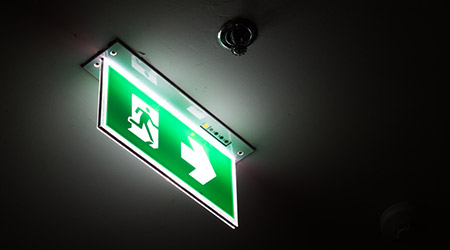From fire-fanning winds in California to thunderstorms across the U.S., inclement weather has the potential to cause power outages. One survey found one in four U.S. businesses reported losing power at least once a month.
During an outage, primary lighting may go out, making it more difficult to navigate buildings. Maintaining emergency and exit lighting can be vital for helping occupants safely navigate to other areas or outside in these situations. With winter weather over and summer storms on the way, the time is now for facilities to check or repair emergency and exit lights. Facility managers should understand the role of emergency and exit lighting and the importance of maintaining these units.
Finding the way out
In the event of an emergency such as a fire, employees and guests may need to quickly find an exit or a safe place within the facility. In the event of a power outage, visible exit signs and backup emergency lighting throughout the building can help guide a business’s employees and guests. Since a survey revealed over a third of U.S. workers would not feel very confident in their ability to navigate their building safely, these devices become increasingly important in emergency situations.
The National Fire Prevention Association (in NFPA 101) requires exit signs to be visible from no more than 100 feet or the listed viewing distance of the exit sign. NFPA also mandates these signs in all “egress paths,” which are defined by specific criteria, laid out in Section 1003 of the International Building Code, including ceiling height and continuous width. Many exit signs are lit by incandescent bulbs. Business owners should consider exit and emergency lighting that is internally wired into emergency backup power, which provides continuous lighting in the event of a power outage. In many cases internally wired backup power may not be available, so facility owners should consider sources of readily available replacement batteries for any battery-backed units.
Lighting the path ahead
Property owners and managers are responsible for maintaining their illuminated exit signs and emergency lighting. They should consider enlisting the help of a trusted partner for this crucial process. To help maintain these units, consider the following processes:
- Visual inspections. Look for loose or exposed wiring and make sure it is secure. Ensure that units are securely mounted to the wall or ceiling.
- Functional inspections. Emergency and exit lighting should undergo various functional tests on a monthly and annual basis, as referenced in NFPA 101 and other building and life safety codes. Building owners should consult with their local AHJs to determine which tests and applicable standards are being enforced in their market. These tests are designed to both check for damage to the exterior of the lights and help verify that the lights are functional.
- Recordkeeping. Keep written records of testing and any additional maintenance for the AHJ to review. For any lights that were not tested, document the location of the lights and a reason for the lack of testing.
Addressing a growing problem
The recent National Climate Assessment warned that “extreme weather events are expected to increasingly disrupt our Nation’s energy and transportation systems, threatening more frequent and longer-lasting power outages.” Thunderstorms and wind gusts can threaten power lines and power grids. This highlights the importance of maintaining functional emergency lights and exit signs.
Emergency lighting helps people to see clearly, avoid obstacles, locate equipment and move more safely throughout a building during a power outage. Working with a reliable service provider for help maintaining and testing these devices can give building occupants peace of mind and help things go smoothly during a power outage.
Taylor Brummel is the director of marketing for Cintas Fire Protection.

 UF Health Hospitals Rely on Green Globes to Realize Their Full Potential
UF Health Hospitals Rely on Green Globes to Realize Their Full Potential How Healthcare Facilities Can Be Truly Disaster-Resilient
How Healthcare Facilities Can Be Truly Disaster-Resilient TriasMD Breaks Ground on DISC Surgery Center for San Fernando Valley
TriasMD Breaks Ground on DISC Surgery Center for San Fernando Valley Bigfork Valley Hospital Falls Victim to Data Breach
Bigfork Valley Hospital Falls Victim to Data Breach AI-Driven Facilities: Strategic Planning and Cost Management
AI-Driven Facilities: Strategic Planning and Cost Management